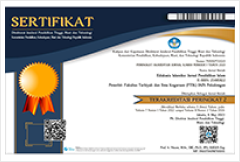The Role of Pesantren and Its Literacy Culture in Strengthening Moderate Islam in Indonesia
DOI:
https://doi.org/10.28918/jei.v8i2.1729Keywords:
Religious Moderation, Literacy Culture, PesantrenAbstract
This research discusses Islamic boarding schools' efforts to strengthen religious moderation values through a culture of literacy among their students. Islamic boarding schools are dedicated to providing an environment where students are immersed in reading, writing, and studying various classic and contemporary literature (books) in pure Arabic (fusha) and Arabic Jawi-Malay (pegon) daily. This research aims to examine literacy issues in Islamic boarding schools related to motivation, development models, efforts made by Islamic boarding schools, and the literacy contribution of santri-alumnae in strengthening religious moderation using a qualitative approach and descriptive method. The study employed various data collection methods, including observation, interviews, and documentation. Data analysis involved several techniques, such as data reduction, display, decision-making, and verification. The findings in this research are: First, the motivation for students to develop a culture of literacy includes theological motifs of the deepening religion, teachings, and missions of Islamic da'wah, messages and examples of kyai, the obligation to make presentations of papers and treatises (students' final assignments), hobbies, interests, and talents, as well as economic motives. Second, the literacy development model for students is carried out individually and in groups using habituation methods that are realized in routine, spontaneous, and exemplary activities. Third, Islamic boarding schools' efforts to increase student literacy are carried out structurally (formally) and culturally (culture). By implementing and strengthening this literacy culture, students can develop broad religious insight, which preaches the Islamic values of tasāmuh (tolerant), tawāzun (balanced), and tawassuṭ (middle), as well as grounding the concept of peace for all (raḥmatan li-l ʿalamīn). Fourth, the contribution of Nurul Ummah students can be seen from their written works of thought in various scientific works in the form of books, articles, and other writings published by book publishers, newspapers, and scientific journals. Of course, there is the contribution of Nurul Ummah alumnae who have been involved in the community, filling in various Islamic religious studies in their respective educational institutions, such as pesantren, schools/madrasas, campuses, and majlis taklim, as well as their religious studies on channels, media accounts, and electronic devices such as Facebook, Youtube, WA Groups, Twitter, and Instagram.
References
Abidin, Y. (2018). Pembelajaran Literasi. Bumi Aksara.
Ahmad Ali Azim. (2019). Tradisi Literasi Pesantren: Manajemen Pendidikan Literasi Di Pesantren Kreatif Baitul Kilmah Yogyakarta. UIN Sunan Kalijaga Yogyakarta.
Akbar, U. dan. (2009). Metodologi Penelitian Sosial. Bumi Aksara.
Alhumami, A. (2018). Literasi Sebagai Gerakan Kebudayaan. Kementerian BPPN/ Bappenas.
Canisius, P. (2012). The Makin Of Reading Society, Developing a Culture of Reading in Rwanda. Linköping Studies in Behavioural Science. Linköping University, Department of Behavioural Sciences and Learning.
Conro, J. C. (2015). Religious Iliteracy in School Religious Education. Policy Press North America Office.
Higton, D. F. & M. (2015). Religious Iliteracy in the Context of Theology and Religious Studies. Policy Press North America Office.
Jayadi, A. (2022). Membangun Kemampuan Literasi di Era Digital. https://mediaindonesia.com/opini/528370/membangun-kemampuan-literasi-di-tengah-era-digital
Koentjaraningrat. (2013). Teori-teori Kebudayaan-Dari teori Hingga Aplikasi. Pustaka Setia.
Long, E. (2008). Community Literacy And The Rhetoric of Local Publics. Parlor Press and The WAC Clearinghouse United States of America.
Mursyid, M. K. & M. (2014). Gerakan literasi Mecerdaskan Negeri. Aswaja Perssindo.
Nurmalina, K. & S. (2008). Memahami Pendidikan Kewarganegaraan. Laboratorium PKn.
Olasehinde. (2015). Promoting The reading culture Towards human Capital and Global Development. English Language Teaching, Vol.8, no.
Permatasari, A. (2015). Membangun Kualitas Bangsa dengan Budaya Literasi. Seminar Nasional Bulan Bahasa, 153.
Prothero, S. (n.d.). Religious Literacy. Harper Collin e-books.
Rubin. (1995). Teaching Elementary Language Arts. Allyn and Bacon.
Salim, M. I. (2019). Syarah Diwan Imam Asy-Syafi’i : Untaian mutiara hikmah dan petunjuk hidup Imam Asy-Syafi’i. Diva Press.
Saryono dkk, D. (2016). Kemajuan Peradaban, Budaya Literasi dan Perkembangan Susastra. In D. Adip Arifin (Ed.), Prosiding Nasional (p. 1). STKIP PGRI Ponorogo.
Suhendra, B. H. &. (2015). Mutu Pendidikan. Bumi Aksara.
Warnick, B. (2001). Critical Literacy in A Digital Era. In Critical Literacy in A Digital Era. https://doi.org/10.4324/9781410603838
Wirawan. (2016). Evaluasi Teori Model, Metodologi, Standar, Aplikasi, dan Profesi. PT Rajagrafindo Persada.






















